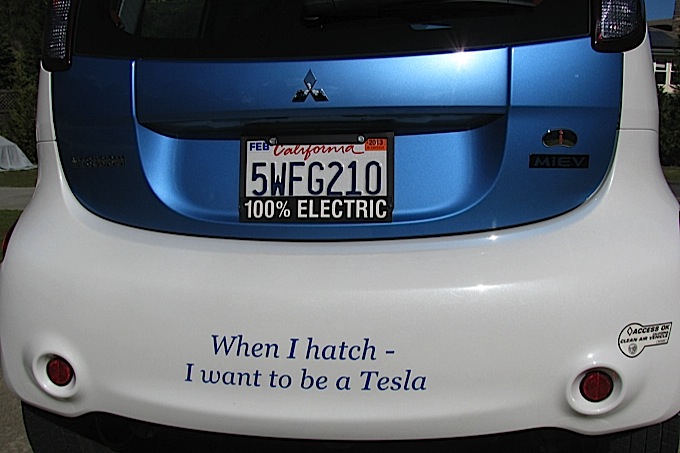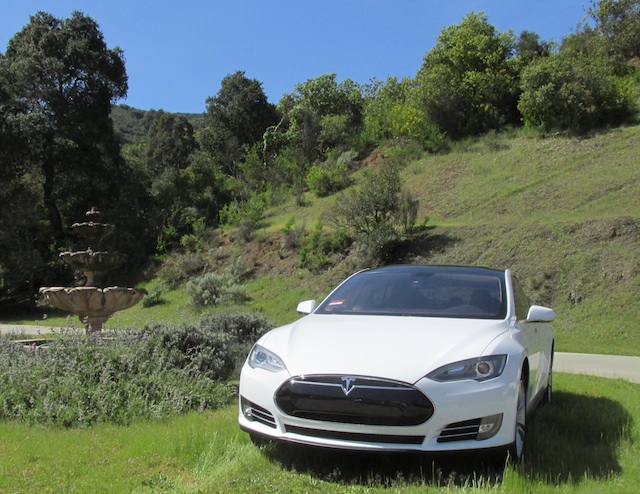OK, we've already put on over 4500 miles in our cross-country Tesla tour and we're heading north up the East Coast to Washington DC after visiting Key West. We took the southern route east using primarily Interstate 10, and so far have been lucky in avoiding floods and tornados.
As I've come to realize, driving the Tesla is no different than driving a luxurious ICE vehicle long distances, the only caveat being that one simply plans ahead where to recharge.
What follows are some of my random thoughts and impressions and contrasts with the i-MiEV.
Range and Charging
I've been driving BEVs for twenty years. My original EcoScoot had a range of about five miles, which meant I had to scrounge a charge if I wanted to get back home from town. My EV conversion pickup has a range of 11 miles, which made for an 'interesting' drive home (uphill) after dinner in town on a 'winter' evening. My Corbin Sparrows have a range of 20 - 50+ miles, and, of course, our i-MiEVs' range is, as we know, whatever we want it to be (nominally 50-80 miles on a single charge).
I mention this to put into context how my perception of 'range' differs from that of the casual observer who invariably asks that question first. With the Tesla, to me, it is a total non-issue, even when crossing New Mexico and Texas on Interstate 10 where there are no SuperChargers. A SuperCharger is a very high-power DC charger that stuffs so much energy back into the car quickly that, invariably, the car is ready to go well before we are. Tesla so-called 'destination chargers' (High Power Wall Charger - HPWC, simply a 240vac EVSE with Tesla connector capable of up to 80A) are now liberally scattered at hotels and restaurants across the country. In any case, there are RV resorts seemingly everywhere with their NEMA 14-50 outlets, lots of private homeowners on PlugShare willing to share their EVSEs, and there are plenty of welding shops in industrial areas if things really became dodgy. As a last resort, plain old 120vac wall receptacles are everywhere and I actually used one a few nights ago as an old friend we were staying with overnight didn't want to leave his door open between the garage and laundry room for access to the 240vac dryer outlet there. My huge collection of adapters simply gives me peace of mind knowing I can plug into anything. I actually used an RV campsite in Van Horn TX for a brief NEMA 14-50 opportunity charge even though I didn't really need it - we were stopping for lunch there, anyway.
To date, our longest drive on a single charge was from Bisbee NM to Las Cruces, NM, a distance of 243 miles (391km). I started with a 95% charge and arrived with 13% remaining, and I purposely used that leg of the trip to see how the car reacted to my driving style. Piece of cake, especially with Tesla's incredibly-accurate range-predicting algorithm.
With proper planning, there is simply no situation when one is idly sitting there waiting for the car to charge - after all, who watches their cellphone charge? Wherever we stop, there's always something to do (usually meals), even if only taking a walk to stretch our legs and explore the surroundings.
So far, every SuperCharger I've gone to has worked perfectly, as have various destination HPWCs.
Oh, and to answer the question: I'm sure I could easily do well over 300 miles in my Tesla MS85 on a single charge.
Range Prediction and Hypermiling
Tesla provides two 'range' metrics you can choose from: State of Charge or Distance (either miles or kilometers). You get to choose one or the other. I personally prefer SoC, but in talking with other Tesla drivers it seems that their heads are wrapped around 'miles'.
I still don't know for sure what variables go into Tesla's range predictions shown on their Trip display graph. I've been told by Tesla reps that the variables are outside temperature, inside temperature, elevation ∆, speed, and airspeed/direction, but, strangely, NOT actual battery capacity. That last one doesn't make sense to me. I sure would like to know exactly what 'speed' Tesla has programmed into that equation so that I can know how to adjust my driving when I need to. In any case, the Tesla display provides a graph at the start of a drive to a destination which shows its end-of-trip SoC prediction (or distance remaining, if you wish) and then provides another line on the graph which shows one's 'actual' performance throughout the trip with dynamic correction of the endpoint. What boggles my mind is how incredibly accurate this thing is when simply driving 'normally'.
As best I can tell, the prediction does not take into account a driver's past pre-trip history, unlike our i-MiEV's RR.
If a destination is programmed that the car can't achieve, it provides lots of cautions and warnings and (much to my dismay) automatically directs you to charging stops along the way - fooled me a couple of times as I thought I was going to a destination in one shot.
Unlike the i-MiEV and its relatively-high coefficient of drag, Tesla's low Cd, coupled with its weight, means that kicking it into neutral on level ground results in the car just rolling and rolling with barely-diminishing speed - a treat for hypermiling. Unlike my driving the i-MiEV, I don't often do this with the Tesla as I still haven't found myself in a situation where I'm trying to eke out every last mile from the car.
Varying one's driving style (e.g., hypermiling) does result in an improvement in the end number, but nowhere near as dramatically as with the i-MiEV.
Anyway, for the long distances the Tesla covers the highly-accurate predictions are appreciated, but for the i-MiEV's short-range daily driving the RR is just fine, IMO.
Simply no such thing as 'Range Anxiety' in either car!
Performance
With the Tesla, you stomp on it and the response is immediate. With the i-MiEV, it takes a couple of (sometimes agonizing) seconds for the car get up and go. With the Tesla I've now had a couple of instances when pulling out onto a high-speed highway from a cross-street where I appreciated the Tesla's acceleration - and mine is only a plain-vanilla 85 model (0-60 in 5.4 seconds) and not the neck-snapping Performance model with Insane or Ludicrous Mode (0-60 in 2.8 seconds). Accelerating onto an Interstate I frequently find myself suddenly realizing the car is up to 90mph … oops.
Recall, the NA version of the i-MiEV's 0-60 is 14+ seconds (in other countries it's around 12 seconds), but we have an 8-year battery warranty. I think that's the reason Mitsubishi put a time delay into the i-MiEV's acceleration, but perhaps it's to limit loading on the drivetrain. Hey, I still think the i-MiEV is nice and peppy, no matter what the numbers say.
The Tesla's handling is excellent IMO, but this is a very heavy car and I am still not comfortable with fast cornering on wet roads. Haven't pushed its limits and hope to find a large empty lot when in a rainstorm so I can play with it and see what happens.
Regeneration and Stopping
Tesla has quite high regen when one releases the accelerator - good, but not quite as high as the original BMW i3; nevertheless, when driving normally, one-pedal driving is the rule with only a need to step on the brake when the car gets down to 5mph. The i-MiEV is pretty good in that respect with B mode, but unfortunately 'creep' kicks in on the i-MiEV somewhere around 9 mph. Unlike all other BEVs, Tesla's brake pedal only actuates the brake without increasing regen (note that the i-MiEV significantly increases regen even when in B-mode when the brake pedal is depressed). I haven't experienced the need for an emergency stop in the Tesla but I'll be surprised if it's better than the i-MiEV simply due to the weight difference between the two cars. Probably need to look up some car-test results (other than Consumer Reports) to see what the numbers are.
The Tesla does provide a 'Creep' mode simulating an ICE automatic transmission - one of many features that can be enabled or disabled. I've used both, and have settled on disabling 'creep', although I've come to like the i-MiEV's 'creep' feature.
The car only has two regeneration settings: 'Standard' which is pretty aggressive, and 'Low' which is meant to simulate an ordinary ICE automatic transmission. I personally would like a 'zero-regen' option for hypermiling on long open-highway stretches, as well as an even more-aggressive 'high-regen' setting for both city and mountain road driving.
Cruise Control
I do not have the latest Tesla model with the sensors to enable Autopilot, Summon, AutoPark, etc., but do have a plain old dumb speed-control capability. This definitely is inferior to manual driving for maximizing range: changing the speed control by even one mile per hour results in a sudden power spike. On level ground and climbing up a simple overpass the car unnecessarily sharply adds power, only to sharply drop into regen on the downhill side. IMO I would sure like to have a de-sensitized option for CC. Better yet, give me a 'throttle' that merely applies power at a constant setting - so what if it slows down on an overpass? As I discussed in the section on hypermiling, there is a scenario that differs between BEV and ICE: in order to maximize range, going down hill and artificially restricting the car's speed using regen is preferable to simply letting the car coast. Cruise Control does this very well.
Comfort
Having put in a number of long driving days in the Tesla, both my wife and I are amazed at how rested we feel at the end of the day - I think it's due to the car's silence rather than the fancy leather seats. The legroom, both in the front and back, in the Tesla is amazing. Getting in and out of the Tesla is certainly more difficult than the i-MiEV when transporting elderly friends.
Battery Management
As the car is pumping over 300A dc into the batteries from a SuperCharger in sweltering 100degF (38degC) heat I can't help but be thankful for its liquid-cooled battery environment. The battery thermal control system kicks in when needed, very noticeable audibly from outside the car when charging.
Air Conditioning
The aircon for humans has been on every since we left home - Tesla does offer some range-extending climate control attenuation features, but I haven't felt the need to use them. A recent post on the Tesla forum allowed as maybe this feature even raises the battery temperature slightly - something I want to stay away from for now.
Displays
The car has two - the huge thing in the middle and the one in the dashboard in front of the driver. Both are programmable with well-thought-out features. I appreciate having so many car settings adjustable to meet my own specific desires. Still learning and, when driving, I have to restrain myself from using the main display and simply ask my wife to access the feature(s) I'd like displayed at the moment. The car is always connected via AT&T 3G (if there's a signal), and even has a Web browser built into that display! Comes with access to an incredible variety of Internet audio.
'Nuff for now. I was going to address cultural differences between Silicon Valley and what I've experienced during this trip in some parts of the country, but it's too hot to put a flame suit on. Thanks for bearing with me and I'll be happy to answer any questions, recognizing that I'm still a Tesla novice.



































